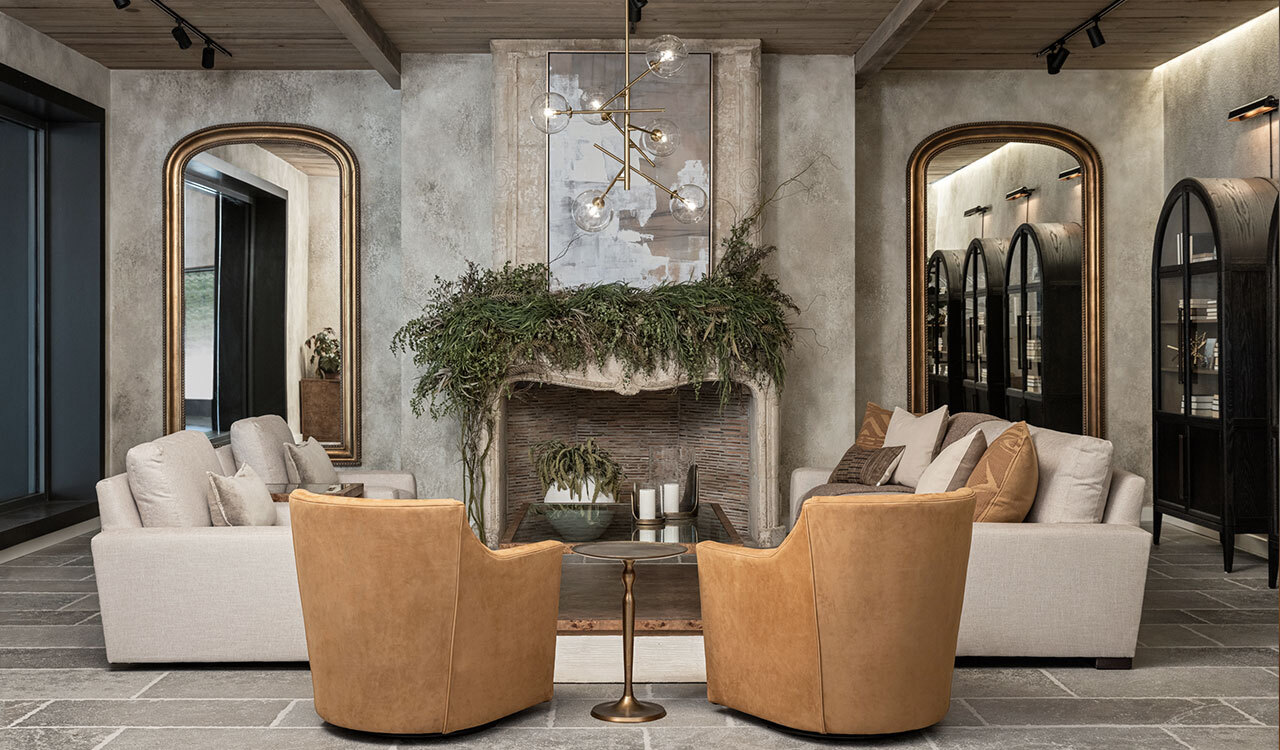The U.S. luxury market is rapidly falling into a recession (if it isn’t already there), according to Chandler Mount, founder of the Affluent Consumer Research Company. His firm’s latest survey of affluent luxury consumers (average income, about $400k) finds their financial confidence has dropped from an index of 64.2 points in June, the highest it’s been all year, to 55.6 points in October, its lowest. And the index measuring future luxury spending has declined from 58.3 points in June to 49.7 points.
“While an RH Gallery might be a destination for a drink in a beautiful environment when you step away to browse the furniture showrooms, your mood could turn from celebratory to shock after seeing the price tags.”
Downward Spiral
Across the 22 luxury goods and services/experiential categories included in the survey, all show a downward shift in purchase incidence over the last three months, with home-related purchases particularly hard hit. Luxury real estate dropped from 20 percent earlier in the year to nine percent most recently and luxury brand furniture/home decor declined from 28 percent to 14 percent.
The leading luxury home furnishings and furniture retailers are already feeling the pinch. But one company stands above, Arhaus.
Swimming Against the Tide
Some of the weaker companies, like Z Galleries and Mitchell Gold + Bob Williams, have folded into bankruptcy. And others are seeing their revenues and profits take a dive as the year progresses:
- RH revenues are down 19 percent in its most recent quarter
- Ethan Allen’s dropped 24 percent
- Williams Sonoma, parent of near-luxury Pottery Barn and West Elm, was off 13 percent
- MillerKnoll, with luxury brands Herman Miller, Design Within Reach and Holly Hunt in its portfolio, reported sales down 13 percent most recently.
And then there’s Arhaus, a company that joined this elite group in the IPO class of 2021. But it’s hardly a newbie. It was founded in 1986 as a solo furniture store in Cleveland, OH by Jack Reed and his son, and Arhaus’ current CEO, who grew up in the company. Going against the industry trend, Arhaus just ended its fiscal third quarter up two percent, from $320 million to $326 million, not a significant bump in normal times, but compared to its direct competitors, it’s significant. More impressive is its 12 percent growth in comparable demand. This key performance indicator measures orders booked before they are delivered and revenues posted to the balance sheet. Through the first nine months of the year, Arhaus revenues have advanced eight percent, reaching $944 million from $872 million.
The brand’s tailwinds allowed the company to raise its guidance from $1,250 million at the low end to $1,265 million. And it will end 2023 with 11 new showrooms to add to the 81 locations it operated at the end of 2022. It’s got a foothold in 29 states and sees the potential to grow to 165+ locations. It plans to open five to seven new showrooms annually for the “foreseeable future” to broaden its reach. New Showrooms are expected to generate $10+ million in sales with payback on the investment in less than two years
Defining Differences
Among Arhaus’ competitive set, RH seems to be the closest. Both are vertically integrated and have a similar range of custom-designed styles and designs, although Arhaus beats RH on price. They both offer interior design services and operate a similar number of locations; RH has 67 Design Galleries plus 14 Waterworks showrooms; Arhaus will end 2023 with 92 Showrooms and Studios.
RH isn’t content to just sell home furnishings to help people design beautiful, liveable homes. It has much grander ambitions, envisioning itself as an “ecosystem of Products, Places, Services and Spaces that inspire customers to dream, design, dine, travel and live in a world thoughtfully curated by RH.”
That’s a pretty ambitious zeitgeist concept — not to mention as a mission for a single company to manage successfully, even with a visionary and inspiring leader like Gary Friedman.
Arhaus has a much more modest mission: “We are founded on a simple idea: furniture should be responsibly sourced, lovingly made and built to last,” as expressed by CEO John Reed. Who can argue with that?
While an RH Gallery might be a destination for a drink in a beautiful environment, when you step away to browse the furniture showrooms, your mood could turn from celebratory to shock after seeing the price tags.
Retail as Theater
Arhaus may not have the wine, but their stores are designed to make customers happy. One thing both Reed and Friedman would agree on is that retail is a stage. “We believe that retail is theater and our stores should be a place for customers to come and get inspired,” Reed said. Arhaus sets its “livable luxury” stage in two primary formats: large-scale Showrooms and smaller Design Studios.
Its 80-odd flagship Showrooms, with an average 16,000 square feet, are where customers are introduced to the full theatrical Arhaus in-store experience. The company employs visual managers to design room-like settings and routinely change it up to keep displays fresh.
Sales associates engage with customers on the floor, are trained in product specifics, and tell the stories behind the design and inspiration of the featured products. In almost all Showrooms, interior designers are available to advise customers and make house calls. Expanding the design services program to all Showrooms is a priority, with Reed noting the company can’t keep up with customer demand. It sees great growth possibilities ahead as clients who engage with the design service have an average order value (AOV) more than four times that of a standard customer. Designer-service clients also have a greater lifetime value, with the company finding some 40 percent of those clients make five or more purchases over time. The company also sees an opportunity to expand its to-the-trade program, offering independent designers exclusive benefits plus a quarterly commission on sales they bring in.
In addition to the flagship Showrooms, Arhaus operates six smaller Design Studios, around 5,000 square feet. These locations maximize complimentary in-home design services with a limited selection of products. As a result, Design Studios generate lower net revenue but make a greater margin contribution of about 36 percent to the Showroom’s average of 32 percent. Three outlet stores round out the retail mix.
Integrated Platforms
Like RH, Arhaus capitalizes on synergies from its omnichannel approach to brick-and-mortar retail, ecommerce, direct-mail catalogs and digital marketing to drive sales. The physical stores act as brand billboards, therefore some 80 percent of ecommerce sales originate within 50 miles of a Showroom location. Last year, nearly 20 percent of revenues were realized online, and most in-store customers window shop online before trekking to the store.
The company launched a new website at the end of 2021 with enhanced virtual tools and online chat for expert advice. “We’ve been working really hard to bring the same experience and emotional connection to life online through Arhaus.com,” CFO Dawn Phillipson said in the third-quarter earnings call. Sales associates also have an advanced suite of technology tools to support in-store customers.
And while the company is active via digital and social media marketing, it’s part of the direct mail renaissance to bridge the digital divide with bi-annual catalogs mailed to “millions” in January and September to engage potential customers in a tactile way. It also distributes thematic catalogs to its customer mailing list including outdoor living and holiday and targets recent movers by sending postcards and mailers.
Recessions Provide Opportunity
The company has identified a total addressable market of around $100 billion in the luxury home furniture market, noting that the high end of the market is traditionally highly fragmented and spread across small local niche players without scale. Arhaus’s biggest hurdle is to build brand awareness, which is relatively low (34 percent) compared with its competitive set.
“The retailer remains in the early innings of its growth trajectory. Segmenting the luxury furniture market suggests Arhaus is attractively positioned above [e.g., Pottery Barn] and below [e.g., RH] major competitors, where its high-quality and price points make it a growing authority for wealthy shoppers,” TD Cowen’s Max Rakhlenko reported.
He is also positive on Arhaus’ aggressive stance relative to the other competitors that are inclined to back off as the luxury furniture recession takes hold: “TD Cowen estimates the furniture industry could decline 5.5 percent as a base case, and in a bear market case could decline as much as 10.8 percent on a PCE basis. We believe companies that invest in growth during slowdowns are the ones that best position themselves to benefit the most on the other side of the cycle. As such, we believe Arhaus’s investments in brand building will allow the company to see strong revenue and margin recovery once the backdrop improves.”
Reed closed the latest earnings call with the rhetorical question, “Many of you have asked why Arhaus is consistently outperforming the industry.” His reply: “The why is our passion and our people. We love designing and working with our incredible vendors to produce beautiful furniture that can be enjoyed for generations.”
In other words, Arhaus delivers maximum value for the price, which is a winning formula for any brand, even in the luxury sphere. It resists grandiose ideas, like RH’s Friedman that are too easily tripped up in execution. Arhaus might be called “RH-Lite,” but that would not tell the whole story. As long as Reed and team stick to their knitting and the company’s proven formula, Arhaus is likely to remain ahead of its competitive set in performance, especially as the luxury home furnishings market continues to head south.




